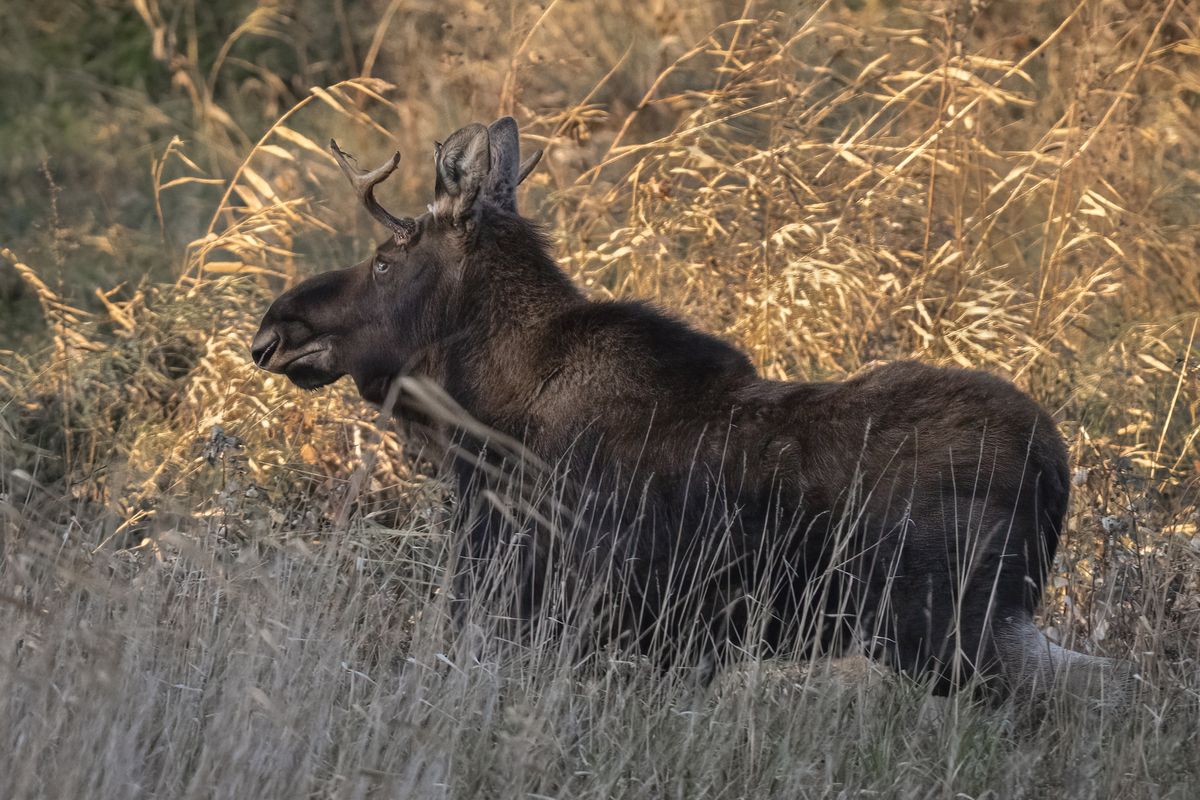A moose is on the loose in Minnesota. Thousands are tracking him.

Brenda Johnson was confused at the notifications she started getting last month on a dormant Facebook page she created years ago.
People were commenting on the page “Central MN Moose on the Loose” and posting photos of their sightings of a young bull moose one resident had named Rutt. They said they’d seen the massive creature slowly walking alone across south-central Minnesota farmland, to their great surprise. This was hundreds of miles outside of a natural moose habitat.
“It’s like seeing polar bears in Texas,” one excited resident wrote.
The moose that prompted the initial Facebook page in 2018 was hit by a truck and killed while crossing a highway, said Johnson, 56, who lives in Dassel, Minnesota.
“Everyone was really sad to lose him,” Johnson said.
So when another moose was spotted roaming through the fields, he became a bit of a sensation.
Johnson quickly renamed her group page for Rutt, and people tracked the antlered animal starting about 500 miles from the northeastern Minnesota and Canadian border known for being a moose habitat.
He was slowly making his way back north.
“Everyone was excited to see him – we’ve all been cheering him on as he heads north,” Johnson said, explaining moose are typically found in the northeastern part of the state near the Canadian border, about 275 miles from where she lives. “Some of them said he’d been spotted even earlier in South Dakota and Iowa, hundreds of miles from where a moose should be.”
Within weeks, her group page went from about 1,000 followers to more than 36,000.
People are breathlessly posting about the enormous mammal, making crafts and coloring pages of him. Someone painted a rock in his likeness, and other people have created Rutt Christmas ornaments. Newspapers, including the West Central Tribune, have featured him.
“This should be our new Minnesota flag!” someone commented about the painted rock.
Bernie Stang said she spotted the moose and photographed him in late October, believing he was lost and steadfastly making his way to his moose family.
“This moose has no clue how much joy and happiness he has brought to so many,” Stang said. “I think the world was hungry for a happy story.”
The moose is estimated to be about a year and a half old, Johnson said, and he was named by Stang’s daughter, Holly Stang, after a moose in the 2003 animated movie “Brother Bear.” Holly Stang is one of the people who had taken videos of the moose when he was spotted near Grove City, Minnesota.
Nobody is sure how Rutt ended up hanging out in harvested cornfields, but it’s rare to see a moose in a prairie environment, said Todd Froberg, the coordinator of the big-game program at the Minnesota Department of Natural Resources.
Moose are generally solitary animals that like cold climates and gravitate to dense forests near water in the winter. They grow to about 6 feet tall, and their height makes it difficult for them to bend down to eat grasses, so they generally survive on twigs, tree bark and pine cones on which they forage above ground level. Their typical life span in the wild is 10 to 12 years.
“A majority of Minnesotans have not seen a moose in the wild,” Froberg said, adding that moose mostly live in isolated areas of the north. “They’re huge animals, so (Rutt) would definitely stand out in the farmland region.”
Froberg said Minnesota has about 3,600 moose, down from a 2005 population of more than 8,000 because of climate change, changes in forestry composition and diseases including brain worm. Nationally, a total of about 300,000 moose live in 19 states, according to Wildlife Informer.
“The population decline isn’t just because of one thing – it’s an accumulation of many things,” Froberg said.
Rutt appears to be healthy, so wildlife officers do not plan to intervene and relocate him, he said.
“We’ll let it be a moose and go back to wherever he’s going,” he said. “Moose are nothing to mess around with, so for the welfare of the public and the animal, I wouldn’t get too close.”
The tall herbivores weigh up to 1,600 pounds and can be dangerous: In September, a moose was spooked by a woman walking her dog in Colorado, and the startled animal head-butted her and stomped on her.
Followers of Johnson’s group Facebook page were worried when Rutt wasn’t seen for about a week in mid-November. They thought he might have suffered a similar fate to the first moose featured on the “Moose on the Loose” page, Johnson said.
“We all took a deep breath on November 19th when Rutt was spotted again and we realized he had safely made it across the interstate and was still heading north,” Johnson said. “Pretty soon, he’ll be in the forest, closer to moose territory, and we won’t see him as much.”
Rutt’s Facebook followers say they are thankful they’ve had the opportunity to watch him virtually on his journey north.
“This has been so neat to watch him as he made his journey home,” one woman wrote on Johnson’s Facebook group page. “Feel almost emotional that we will eventually lose track of him, but glad he is getting to where he wanted to be. Live long and happy Rutt!”
Johnson has put together a list of everywhere the moose has been seen, from Flandreau, South Dakota, to Sebeka, Minnesota. If anyone sends new photos, she’ll wait for several hours to post them to discourage people from showing up at the spot where Rutt was spotted and possibly bothering him, she said.
“My favorite part of this is how everyone has come together to root Rutt on,” Johnson said. “I haven’t seen him personally, but I’ve received so many messages about the joy he’s brought to people’s lives.”
“It’s fun to watch him find his way home,” she said.